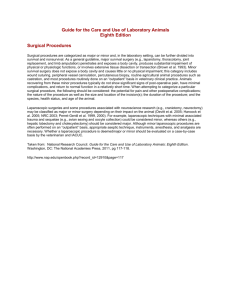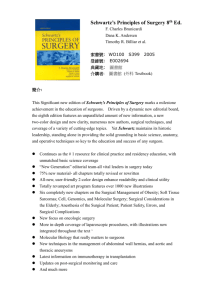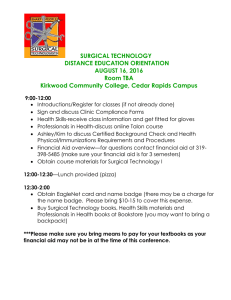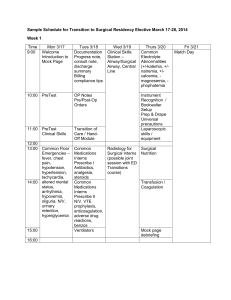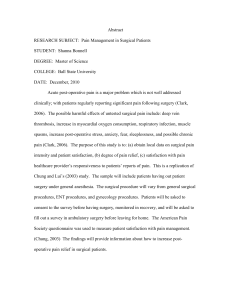On Defining Metrics for Assessing Laparoscopic Surgical Skills in a Virtual Training Environment
advertisement
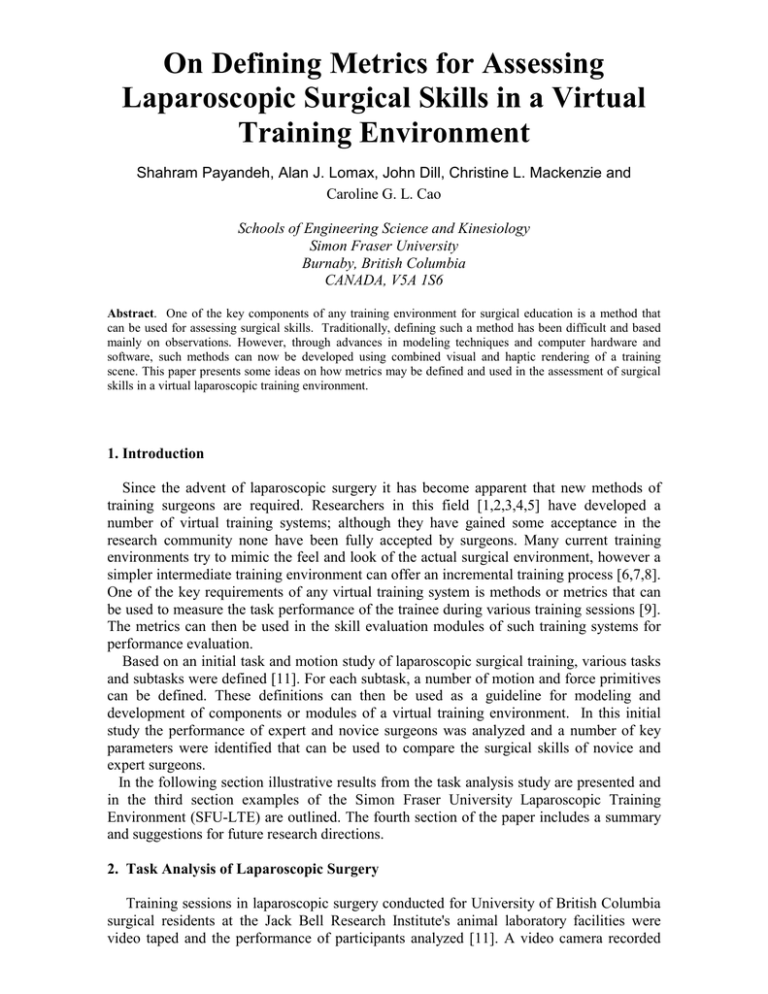
On Defining Metrics for Assessing Laparoscopic Surgical Skills in a Virtual Training Environment Shahram Payandeh, Alan J. Lomax, John Dill, Christine L. Mackenzie and Caroline G. L. Cao Schools of Engineering Science and Kinesiology Simon Fraser University Burnaby, British Columbia CANADA, V5A 1S6 Abstract. One of the key components of any training environment for surgical education is a method that can be used for assessing surgical skills. Traditionally, defining such a method has been difficult and based mainly on observations. However, through advances in modeling techniques and computer hardware and software, such methods can now be developed using combined visual and haptic rendering of a training scene. This paper presents some ideas on how metrics may be defined and used in the assessment of surgical skills in a virtual laparoscopic training environment. 1. Introduction Since the advent of laparoscopic surgery it has become apparent that new methods of training surgeons are required. Researchers in this field [1,2,3,4,5] have developed a number of virtual training systems; although they have gained some acceptance in the research community none have been fully accepted by surgeons. Many current training environments try to mimic the feel and look of the actual surgical environment, however a simpler intermediate training environment can offer an incremental training process [6,7,8]. One of the key requirements of any virtual training system is methods or metrics that can be used to measure the task performance of the trainee during various training sessions [9]. The metrics can then be used in the skill evaluation modules of such training systems for performance evaluation. Based on an initial task and motion study of laparoscopic surgical training, various tasks and subtasks were defined [11]. For each subtask, a number of motion and force primitives can be defined. These definitions can then be used as a guideline for modeling and development of components or modules of a virtual training environment. In this initial study the performance of expert and novice surgeons was analyzed and a number of key parameters were identified that can be used to compare the surgical skills of novice and expert surgeons. In the following section illustrative results from the task analysis study are presented and in the third section examples of the Simon Fraser University Laparoscopic Training Environment (SFU-LTE) are outlined. The fourth section of the paper includes a summary and suggestions for future research directions. 2. Task Analysis of Laparoscopic Surgery Training sessions in laparoscopic surgery conducted for University of British Columbia surgical residents at the Jack Bell Research Institute's animal laboratory facilities were video taped and the performance of participants analyzed [11]. A video camera recorded the surgeon's hand movements. In addition the image of the operative site in a pig abdomen, including the end-effectors of the manipulators, from the endoscopic camera was combined with the view of the surgeon's hands using a digital mixer and recorded on the same videotape. These two images were displayed on the monitor as a split-screen view. (See Figure 1 ). In this way we were able to conduct time-line studies of tool movements during various surgical tasks. Figure 1 split-screen view of an actual training session. Evaluation of the videotaped training sessions identified five basic motions that the surgeon/tool performed: reach and orient; grasp and hold/cut; push; pull; and release. Four surgical tasks were evaluated in detail, suturing, tying knots [10], cutting suture and dissecting tissue. Through time-line analysis of the tasks performed by the novice and expert surgeons, the time duration of these basic tasks was used as an independent parameter for comparing various subtasks. For example, Figure 2 shows the breakdown of the dissecting tissue task into two sub-tasks namely pull taut tissue and snip tissue. It also shows the average time for novice surgeons compared to expert surgeons. It can be concluded from this analysis that a measure of performance differences between novices and experts is the length of time taken to complete the pull taut tissue subtask. Figure 2 Timeline for the dissecting tissue task, with two subtasks. Figure 3 shows a breakdown of the suture task into seven subtasks. These subtasks are: position needle; bite tissue; pull needle through tissue; reposition; re-bite tissue; re-pull needle; and pull suture through. Figure 4 shows the average time obtained through timeline analysis of videotapes of these subtasks. It can be seen that compared with expert surgeons, novices took longer, on average, during all the subtasks. Hence, any training system should have components that train novices in these subtasks with the aim of reducing the time taken during the subtasks. Figure 3 Decomposition of suturing into seven subtasks. . Figure 4 Timeline for the suturing task, and the subtask components. 3. Simon Fraser University Virtual Training Environment Our task and motion analysis study confirmed that hand-eye coordination tasks are important in the design of laparoscopic surgery training systems and time is a key measure or metric of performance. Figure 5 shows a training exercise where at the beginning of the session, a red flag appears at various locations on one of the three compliant objects [13]. The objective is for the user to reach and touch the flag with the tip of the tool. At the end of the session, a window appears which shows the net distance traveled and the time of flight. Figure 5 Example of a training session where the user attempts to make contact with the flag and the two metrics used to assess the performance of the user. Figure 6 shows a virtual training scenario designed to develop the skill required in performing one of the five elemental motions of laparoscopic surgery, the grasping movement. Here the user can initialize a timer by pressing on a virtual button in the scene. The objective is for the user to grasp and pluck a marked flag from a compliant object in the scene. Figure 6 Example of the training session where the task performance is measured by measuring the time that it will take the user to pluck a flag post from a compliant object. Dissection was studied as one of the four basic tasks, and figure 7 shows the virtual environment initially designed to train this skill. The goal is to dissect the small cylinder from the large one. As shown in the Figure 2, subtasks are pull-taut tissue and snip tissue. Several measures of user performance were defined. These range from the time between the contacts until the time the object is dissected, to the impedance of the tasks: namely the ratio between the overall force generated during the dissection task and the overall speed of the tip during its trajectory. This latter measure is important since it can give an indication of how fast or slow the user is dissecting the tissue as opposed to ripping the tissue. Another measure is the trajectory of the tip in relation to the direction of the effective pulling of the tissue. Figure 7 shows an example of one of the training sessions where two laparoscopic graspers were used for the dissection task. Figure 7 A training session for the dissection task. The small deformable cylinder is dissected from the larger one. Another training example; we have developed; can be regarded as a metric of tracking dexterity and precision. Here a deformable object is presented in the scene. A nominal trajectory on the object is then generated by the expert or through a lookup library of the paths associated with a certain procedure. The objective of this training phase is for the user to track this nominal path on the deformable object. Figure 8 shows an example of this session. The figure on the left shows the nominal path generated by the expert using a laparoscopic probe while the figure on the right also shows the path generated by the novice. The measures during this phase are, a) the total amount of deviation of the path from the nominal trajectory, b) the force profile on the object created by the novice and c) the total number of contact discontinuities created by a novice when tracing the nominal path. These measures can be the basis for further training of dexterity and precision in this tracking task. The final example of a training session we have developed is an attempt to simulate organ contact and manipulation. An example would be when the surgeon elevates the right lobe of the liver to examine the under-surface of the lobe. Here the purpose is to identify a specific marker that is hidden under a deformable object. In this example, the object is modeled such that it is resting on a surface in a gravity environment. The trainee then manipulates the object by lifting it with the simulated tool. Markers (here a random letter of the alphabet) are hidden under the compliant object. The variable used for measuring the performance of the trainee is the amount of time it takes for the user to lift and identify the letter under the object. Figure 9 shows the wire-frame view of this training session. Here a letter P is hidden under the compliant sphere. The object can also be constrained or attached to other objects in the scene. Our goal is to incrementally enhance the scene to increasingly resemble the actual surgical environment Figure 8 is an example of a training session where the nominal tracing path on a deformable object is generated by an expert surgeon. The trainee then has to trace this path. The metrics of assessment are number of errors, contact discontinuities and excess force Figure 9. Training session involving a compliant object that is resting on a surface in a gravity environment and a laparoscopic tool. The goal is to identify the hidden letter by lifting the object. The metric of performance is time. 4. Conclusion The purpose of this paper is to demonstrate the value of task and motion studies in determining the components of basic laparoscopic surgical skills and that these components should be the basis on which virtual training environments are designed. Eventually for virtual surgical simulation to progress standard measures or metrics of laparoscopic surgical skills will be required. At present highly realistic virtual surgical simulations that also have good interactivity are not possible; we are therefore developing the SFU-VTE using simple objects but with good interactivity. We believe that the models we have designed to date can train basic laparoscopic skills and we will in the near future carry out controlled empirical studies to evaluate this. Progress in the design of simulators for the training of laparoscopic surgical skills will require three parallel approaches: increasingly realistic simulations of surgical environments, the study of human interactivity in real-time systems with minimal lag [12], and content based on empirical studies of surgeons' cognitive processes and visuomotor skills. References 1. U. Kuhnapfel, H.K. Cakmak, H. Maab, Endoscopic Surgery Training using Virtual Reality and Deformable Tissue Simulation, Computer & Graphics, Vol. 24, 671-682 2000. 2. Lapsim simulation, “Surgical Science”, www.surgical-science.com 3. R.V. O'Toole et al, Measuring and Developing Suturing Technique with a Virtual Reality Surgical Simulator. J Am Coll Surg, 189: 114-128, 1999. 4. XiTact SA, www.xitact.com 5. MIST-VR: A virtual reality trainer for laparoscopic surgery assesses performance. Ann R Coll Surg Engl 79: 403-404, 1997 6. R.M.Satava, Accomplishments and challenges of surgical simulation dawning of the next generation surgical education. Surg Endosc 15: 232-241, 2001 7. N.J. Avis , Virtual environment technologies. Min Invas Ther&Allied Technol: 9(5) 333340, 2000 8. P.J. Gorman et al, The Future of Medical Education Is No longer Blood and Guts, It Is Bits and Bytes. Am J Surg. 180 ; 353-355 , 2000 9. S. Smith et al, The objective assessment of surgical skill. Min Invas & Allied Technol 9(5) 315-320, 2000 10. S. Payandeh and A. Lomax, A Knotting theory and knotting mechanisms. Proceedings of ASME 25th Biennial Mechanisms Conference, 1998 11. C. G. L. Cao, C. L. MacKenzie and S. Payandeh, Task and Motion Analysis in Endoscopic Surgery. Proceedings of ASME Dynamic Systems, 5th Annual Symposium on Haptic Interface for Virtual Environment and Teleoperation. 1996 12. Z. Stanisic, E. Jackson and S. Payandeh, Virtual Fixtures as an Aid for Teleoperation. Proceedings of 9th Canadian Aeronautic and Space Institute Conference, 1996 13. Z. Cai, J. Dill and S. Payandeh, Haptic Rendering: Toward Deformation Modelling with Haptic Feedback. Proceedings of ASME Dynamic Systems, 9th Annual Symposium on Haptic Interface for Virtual Environment and Teleoperation, 2000.
